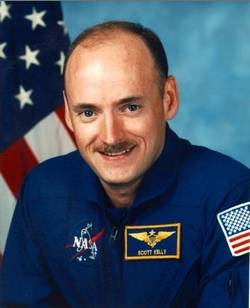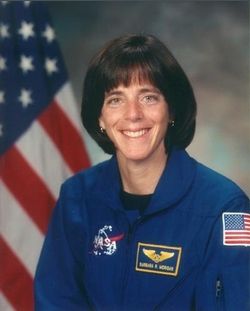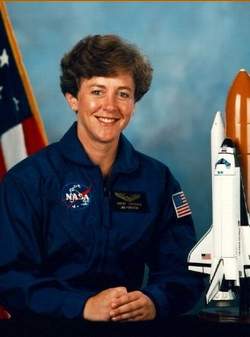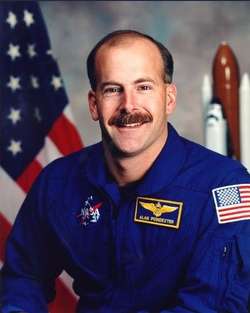 Crews have been assigned by NASA to begin training
for three International Space Station missions. The missions,
scheduled for late 2003 and early 2004, will continue Station
assembly and rotate expedition crews.
Crews have been assigned by NASA to begin training
for three International Space Station missions. The missions,
scheduled for late 2003 and early 2004, will continue Station
assembly and rotate expedition crews.
STS-118, with a six-member crew, is slated for
launch in November 2003. STS-119 will follow with 10 crewmembers,
including Expedition Nine traveling to the Station and Expedition
Eight returning to Earth. STS-120, scheduled for
launch in early 2004, has six crewmembers that will deliver the
U.S. Node Two, marking completion of the U.S. Core assembly.
Scott J. Kelly (Cmdr., USN; above) will command the crew of
STS-118, and Charles O. Hobaugh (Lt. Col., USMC) will be the pilot.
Veteran astronauts Scott E. Parazynski (M.D.) and Dafydd (Dave) R.
Williams (M.D., Canadian Space Agency) will be returning to space
for their fifth and second missions, respectively. Barbara R.
Morgan (below), the newest Educator Astronaut, and Lisa M. Nowak
(Cmdr., USN) round out the crew as mission specialists.
Veterans and rookies...
 The announcement of what will no doubt be known
as "Barbara Morgan's mission" was highlighted
with a ceremony at the Maryland Science Center in Baltimore and
fulfills a commitment by NASA Administrator Sean O'Keefe, to send
an educator into space in a renewed mission to inspire a new
generation of explorers. Morgan's flight represents the first of
what is expected to be many flights as part of a new Educator
Astronaut program, which will be unveiled in early 2003.
The announcement of what will no doubt be known
as "Barbara Morgan's mission" was highlighted
with a ceremony at the Maryland Science Center in Baltimore and
fulfills a commitment by NASA Administrator Sean O'Keefe, to send
an educator into space in a renewed mission to inspire a new
generation of explorers. Morgan's flight represents the first of
what is expected to be many flights as part of a new Educator
Astronaut program, which will be unveiled in early 2003.
Kelly made his first flight aboard STS-103 in
1999 as the pilot, and he trained as a backup flight engineer for
Expedition Five. Hobaugh served as the pilot on STS-104 in 2001.
Parazynski's previous missions are STS-66 in 1994, STS-86 in 1997,
STS-95 in 1998, and STS-100 in 2001. Williams flew aboard STS-90 in
1998. Morgan and Nowak will make their first trips into space.
Veteran mission commander Steven W. Lindsey
(Col., USAF) leads STS-119. The mission's pilot will be Mark
E. Kelly (Cmdr., USN) with mission specialists Michael L.
Gernhardt (Ph.D.) and Carlos I. Noriega
(Lt. Col., USMC, ret).
 Lindsey flew as the pilot on STS-87 in 1997 and
STS-95 in 1998, and as mission commander aboard STS-104 in 2001.
Kelly will be on his second Shuttle mission, having flown on
STS-108 in 2001. Gernhardt will make his fifth mission to space. He
served as a mission specialist on STS-69 in 1995, STS-83 in 1997,
STS-94 in 1997, and STS-104 in 2001. Noriega was a mission
specialist on STS-84 in 1997 and STS-97 in 2000, and he trained as
the backup commander for Expedition Six.
Lindsey flew as the pilot on STS-87 in 1997 and
STS-95 in 1998, and as mission commander aboard STS-104 in 2001.
Kelly will be on his second Shuttle mission, having flown on
STS-108 in 2001. Gernhardt will make his fifth mission to space. He
served as a mission specialist on STS-69 in 1995, STS-83 in 1997,
STS-94 in 1997, and STS-104 in 2001. Noriega was a mission
specialist on STS-84 in 1997 and STS-97 in 2000, and he trained as
the backup commander for Expedition Six.
Expedition Eight commander C. Michael Foale
(Ph.D.), flight engineers William S. McArthur (Col., USA, ret.) and
cosmonaut Valery I. Tokarev (Col., Russian Air Force), will return
from their stay aboard the Station.
Expedition Nine, Station commander Gennadi I.
Padalka (Col., Russian Air Force), flight engineers E. Michael
Fincke (Lt. Col., USAF) and cosmonaut Oleg D. Kononenko will travel
to their home in space aboard STS-119.
 STS-120 will have veteran commander James
D. Halsell (Col., USAF), returning from Kennedy Space
Center, leading the mission, and first-time flyer Alan G.
Poindexter (Cmdr., USN; right) as pilot. Wendy B.
Lawrence (Capt., USN; above), Piers J.
Sellers (Ph.D.), Stephanie D. Wilson and
Michael J. Foreman (Capt., USN) will serve as
mission specialists.
STS-120 will have veteran commander James
D. Halsell (Col., USAF), returning from Kennedy Space
Center, leading the mission, and first-time flyer Alan G.
Poindexter (Cmdr., USN; right) as pilot. Wendy B.
Lawrence (Capt., USN; above), Piers J.
Sellers (Ph.D.), Stephanie D. Wilson and
Michael J. Foreman (Capt., USN) will serve as
mission specialists.
Halsell was the pilot for STS-65 in 1994 and STS-74 in 1995, and
mission commander for STS-83 in 1997, STS-94 in 1997, and STS-101
in 2000. Poindexter is a member of the 1998 class of astronauts.
Lawrence previously flew aboard STS-67 in 1995, STS-86 in 1997, and
STS-91 in 1998, while Sellers has one previous flight, STS-112,
earlier this year. Wilson and Foreman will make their first trips
into space.
 Aero-News: Quote of the Day (12.09.25)
Aero-News: Quote of the Day (12.09.25) ANN's Daily Aero-Term (12.09.25): High Speed Taxiway
ANN's Daily Aero-Term (12.09.25): High Speed Taxiway ANN's Daily Aero-Linx (12.09.25)
ANN's Daily Aero-Linx (12.09.25) NTSB Final Report: Diamond Aircraft Ind Inc DA20C1 (A1); Robinson Helicopter R44
NTSB Final Report: Diamond Aircraft Ind Inc DA20C1 (A1); Robinson Helicopter R44 ANN FAQ: Q&A 101
ANN FAQ: Q&A 101






